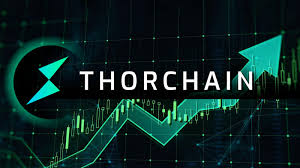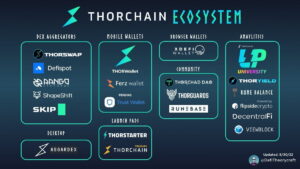THORChain functions as a Layer 1 cross-chain decentralized exchange (DEX) leveraging the Cosmos SDK. It revolutionizes native asset transactions across multiple chains, eliminating the necessity for wrapped or pegged assets. Operating without centralized intermediaries, THORChain ensures transparency and fairness. The protocol’s continuous liquidity pools optimize efficiency, managing assets directly in on-chain vaults with top-tier economic security. Essentially, THORChain resembles a ‘cross-chain automated market maker (AMM),’ akin to Uniswap.
Among THORChain’s intriguing features lies the ‘Savers Vaults.’ These vaults empower users to easily supply single-asset liquidity on the THORChain platform.
Whether holding native Bitcoin or other assets, users can contribute to the platform and earn attractive yields.
The most appealing aspect? Users maintain complete asset control and can withdraw their principal at their convenience.
But how does this remarkable system function in practice?
This article delves into the core concepts of THORChain, providing an extensive exploration of the mechanisms behind their Savers Vaults.

Understanding THORChain’s Functionality
THORChain simplifies cross-chain decentralized protocols by enabling seamless native swaps between diverse blockchains. To comprehend how THORChain operates, it’s crucial to grasp two fundamental concepts: Automated Market Makers (AMMs) and Liquidity Providers (LPs).
AMMs are pivotal for decentralized exchanges (DEXs) like THORChain. They aggregate user liquidity and utilize sophisticated algorithms to determine asset prices within the pool. While mechanics might differ among exchanges, the core benefits remain consistent: deep liquidity, minimal transaction fees, and universal accessibility.
On the other end are Liquidity Providers (LPs) who deposit assets into these pools, creating virtual, asset-specific reserves. In return, LPs acquire a share of the pool as long as their assets remain. Their reward comes from fees paid by swappers, individuals using the pools for asset exchanges. These fees are proportionally distributed among pool owners. Some protocols offer block rewards to enhance the liquidity annual percentage yield (APY).
THORChain stands as an independent blockchain, operating as a Layer 1 cross-chain decentralized exchange built on the robust Cosmos SDK. This configuration enables THORChain to facilitate non-custodial asset exchanges across various blockchains. Essentially, THORChain serves as the foundational infrastructure for diverse user interfaces.
THORChain’s benefits are clear:
- Native Asset Swaps: Easily swap Layer 1 assets across multiple chains, like converting native BTC to ETH without intermediaries.
- No User Registration: No cumbersome registration; simply initiate a transaction, and THORChain handles the rest.
- Asset Purity: Avoid wrapped assets, ensuring all assets are native and secure.
- Transparency and Fairness: Operate with transparent, fair pricing mechanisms without reliance on centralized third parties.
- Continuous Liquidity Pools (CLP): Unlike exchanges like Binance and Coinbase, THORChain employs CLPs offering several key advantages:
- ‘Always-On’ Liquidity: CLPs ensure consistent liquidity for all platform assets.
- Trustless On-Chain Price Feeds: Feeds enable internal and external use, fostering trust in asset prices.
- Democratized Arbitrage: Open arbitrage opportunities for anyone, leveling the field.
- Converging Prices: Through CLPs, pool prices converge to genuine market prices as fees approach zero.
- Fair Fee Distribution: Equitably distribute fee revenue among liquidity providers, rewarding their participation.
- Responsive Liquidity: CLPs adapt to changing liquidity demands, maintaining efficiency and user-friendliness.
RUNE TOKEN
2. Network Security: THORChain’s robust security demands Node Operators to bond twice the pooled RUNE amount. This mechanism incentivizes Node Operators to preserve the network’s integrity and reliability.
3. Governance: Users wield governance power. Through liquidity deposits (symmetrically adding RUNE:ASSET), users cast votes to maintain active pools. Pools with the highest liquidity receive priority.
4. Incentives: RUNE token serves as an incentive source in the THORChain ecosystem. Block rewards, following a predefined emission schedule, are distributed to Liquidity Providers and Node Operators, adding value to collected fees, encouraging participation.
As a settlement asset, security mechanism, governance tool, and incentive provider, the RUNE token is pivotal in the THORChain network. Its multi-faceted utility ensures ecosystem efficiency and empowers users in governance, fostering a vibrant decentralized DeFi landscape.
- RUNE to BTC Swap: Imagine swapping RUNE to BTC. The user sends their RUNE assets to THORChain, initiating the swap. From THORChain’s vaults, BTC is sent to the user. Importantly, inbound gas uses native RUNE, while outbound fees are settled in BTC.
- BTC to ETH Swap: Similarly, for BTC to ETH swaps, users send their BTC assets to THORChain. ETH is sent from THORChain’s vaults. Internally, a sequence of swaps occurs as BTC is received. RUNE shifts from the BTC pool to the ETH pool, resulting in a double swap (BTC:RUNE, RUNE:ETH). Inbound gas is covered in BTC, and outbound fees are settled in ETH.

For deeper insights into the nuances of the swapping process and additional information, you may refer to the ‘Swappers’ section. These mechanisms ensure that swapping in THORChain is not only effective but also seamlessly integrated with the utilization of native assets, thereby enriching the overall user experience.”
The earnings from providing liquidity can help mitigate these losses or even lead to no loss at all. It’s advisable to provide liquidity in pools for which you have a positive or neutral outlook. Emotional decisions triggered by price fluctuations may prompt premature withdrawals and permanent losses.
Savers Vaults in THORChain

Savers Vaults provide a new way to offer single-asset liquidity within THORChain.
Users can easily deposit their native Bitcoin into a Savers Vault and start earning yields in kind.
Notably, they retain complete control of their keys, enabling the flexibility to withdraw their principal at any time.

As of the current writing, the annual percentage rate (APR) for Bitcoin’s Savers Vault stands at 2.4%. While the present yield might not seem particularly enticing compared to other Bitcoin DeFi pools and vaults, it’s vital to recognize that this option ranks among the safest. The security of the Savers Vault relies on the blockchain and THORChain’s nodes, eliminating concerns related to impermanent loss. This sets it apart from numerous other DeFi investment pools and vaults, which often expose users to smart contract exploit risks.
These vaults are primarily designed for long-term depositors as it’s crucial to maintain funds in the vault long enough for the accumulated fees to counter entry/exit costs and the outbound fee(s) upon withdrawal. For more detailed insights into Savers Vaults, please refer to the following information.
- Yield Source: Savers Vaults derive their yield from the liquidity pools within THORChain. This yield is generated through swap fees and block rewards as traders engage in asset swaps. Users of Savers Vaults typically earn approximately half of the yield that a standard RUNE-ASSET liquidity provider would receive over a similar timeframe.
- Yield Rate Calculation: The yield rate varies, driven by swap fees, block rewards, pool depth, and the incentive pendulum. Annual percentage rates (APRs) are determined using data from the past 30 days, although past performance does not guarantee future results.
- Deposit and Withdrawal Fees: Users incur slippage fees when entering and exiting a Savers Vault. These fees increase concerning the deposit size relative to the total pool depth. Smaller deposits and withdrawals result in lower slippage upon entry and exit. Users are advised to carefully consider their deposit and withdrawal size, as fees are final upon transaction completion. Additionally, liquidity fees for entry and exit are responsive to demand, serving to prevent economic attacks, while network fees cover gas costs, ensuring system sustainability.
- Security and Risks: THORChain implements multiple measures to secure assets deposited in Savers Vaults. The network comprises approximately 100 anonymous nodes, each bonding RUNE to validate blocks and earn rewards. Additionally, there are 5 Asgard Vaults, each controlled by 20 randomly selected nodes through Threshold Signature Schemes (TSS). No single entity can unilaterally control user funds. In the event of a loss, node bonds are slashed to recover losses, as all vaults are consistently overcollateralized. On-chain solvency ensures transparency. Nevertheless, it’s essential to note that Savers Vaults, like any investment, carry inherent risks. Although designed to mitigate risk, complete elimination of potential losses is not guaranteed. Users are recommended to thoroughly comprehend these risks before engaging in a Savers Vault.
Other supported crypto assets in Savers Vault
Apart from Bitcoin (BTC), THORChain’s Savers Vaults accommodate various Layer 1 assets, enhancing users’ flexibility and choices. These include:
- Ether (ETH)
- Binance (BNB)
- Litecoin (LTC)
- Bitcoin Cash (BCH)
- Dogecoin (DOGE)
- Cosmos Hub (ATOM)
- Avalanche (AVAX)
Accessing Savers Vaults
Users can easily manage their positions in THORChain Savers Vaults through various supported frontends, offering accessibility across different platforms. Some of these frontends include:
- XDefi Web
- THORWallet (Mobile)
- Lends
- Edge Wallet (Mobile)
- ShapeShift
Tracking Savers Vault Yield
For individuals interested in overseeing their Savers Vault positions and yield, THORChain provides specialized interfaces such as THORYield.
Disclaimer
The details provided in this article and its associated sources are not intended as investment, financial, or trading advice. It should not be treated as such, and it is advisable not to base financial decisions on this content. The author of this document does not guarantee the accuracy or timeliness of the information provided. Prior to making any financial decisions, it is recommended to seek guidance from a qualified professional capable of evaluating your specific circumstances and requirements.
